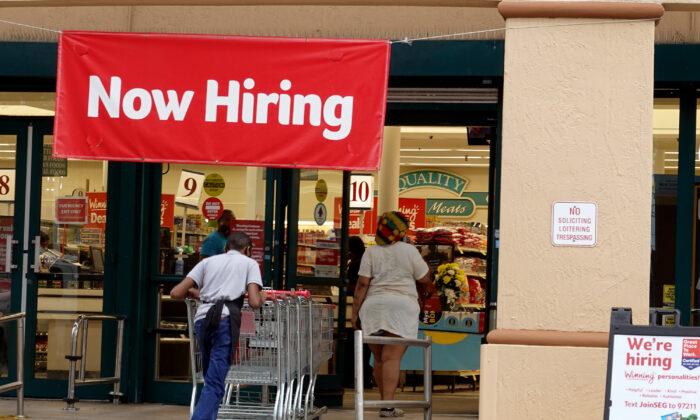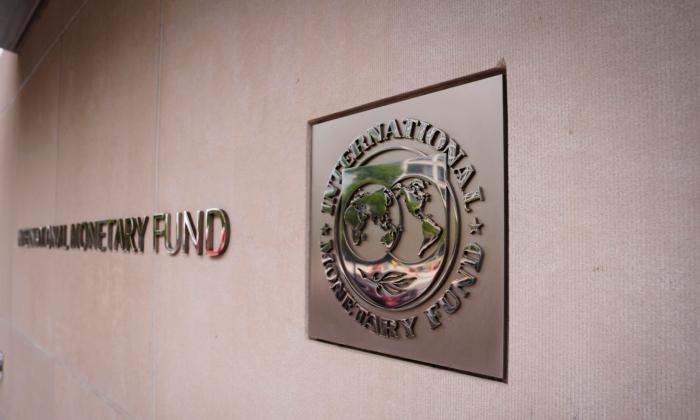The unemployment rate edged up to 4 percent, from 3.9 percent in December. That matched the median expectation.
In addition, the labor force participation rate rose to 62.2 percent, average hourly earnings surged at an annualized rate of 5.7 percent, and average weekly hours slipped to 34.5.
Employment gains were concentrated in three sectors: leisure and hospitality (151,000), professional and business services (86,000), and retail trade (61,000). Construction, financial activities, information, manufacturing, and mining labor numbers were little changed.
Overall, employment remains 2.9 million (or 1.9 percent) below pre-pandemic levels, although “taking into account population growth since Feb. 2020, the jobs shortfall is around 4.5 million,” according to the Economic Policy Institute.
The number of workers absent due to illness rose to 3.6 million in January, when cases of the Omicron virus variant surged.
The Labor Department also revised job gains upward for November and December 2021 by more than 700,000 due to new seasonal adjustment factors in the annual establishment survey benchmarking process. December jobs growth was revised to 510,000 from 199,000 and November job gains increased to 647,000 from the previously reported 249,000.
However, these changes were largely offset by downward revisions to employment data for May, June, and July last year. Overall, the 2021 jobs gain was 217,000 higher than previously reported.
“Today’s employment data show strong growth in jobs for both December and January. They also show continued rapid increases in average hourly earnings,” Robert Genetski, economist at The Heartland Institute, said in an email.
The surprising official payroll numbers came after a weak private sector employment report on Feb. 2.
The drop in private-sector jobs was seen across all industries and business sizes, with the leisure and hospitality industry accounting for more than half of the decline, ADP pointed out.
“So, we just wanted to kind of prepare, you know, people to understand how the data is taken,” she said. “As a result, the month’s jobs report may show job losses in large part because workers were out sick from Omicron.”
The surprising jobs report spiked bond yields and reassured investors that the Fed would continue with its plan to start raising interest rates as soon as next month.
Despite the better-than-expected jobs numbers, the current state of the labor market is “a worker supply problem rather than a demand problem,” Nancy Tengler, CEO & chief investment officer at Laffer Tengler Investments, told The Epoch Times.
In December, the number of job openings climbed to 10.925 million, up from an upwardly revised 10.775 million in November. There were 4.3 million job quits to close out 2021, down from the high of 4.5 million the previous month.
It was an active week on the labor data front.
Unit labor costs edged up 0.3 percent in the October-to-December period, less than the projection of 1.5 percent, as well as the 9.3 percent surge recorded in the three months ending in September.
With the latest upward trend in wage gains, it “is consistent with the continued uptrend in productivity over the next two years,” Deutsche Bank Research stated in a note, adding that nonfarm business sector productivity could increase 3.5 percent in this span.
“In this way, a commonly ignored benefit of the recent wage gains could well be that a productivity boom is in the offing in the U.S.,” the bank wrote.
The Federal Reserve has signaled that the next phase in its quantitative tightening endeavor will involve raising interest rates in March and then begin shrinking its more than $8 trillion balance sheet.
But could the latest employment numbers, and other economic metrics, force the central bank to be even bullish on removing support systems in the economy?
In a separate note, Deutsche Bank stated that it would be up to the market to determine “how far and how fast they may go” on quantitative tightening based on incoming data.
“A meaningful upside surprise would likely push market pricing of rate hikes this year even higher, further flattening the yield curve,” analysts wrote.
Although the prolonged selloff in the financial markets might create bearish conditions, the investors might not focus too long on the January jobs figures, says Bryce Doty, the senior portfolio manager at Sit Fixed Income Advisors.
“Slowing COVID cases combined with a Fed unlikely to be deterred from its mission to raise rates should keep investors from dwelling too long on January’s economic data,” he told The Epoch Times.
At the same time, even with pessimistic consumer sentiment, the Fed might not place a ceiling on its efforts to unwind monetary stimulus after the recent jobs report, other strategists warn.






Friends Read Free